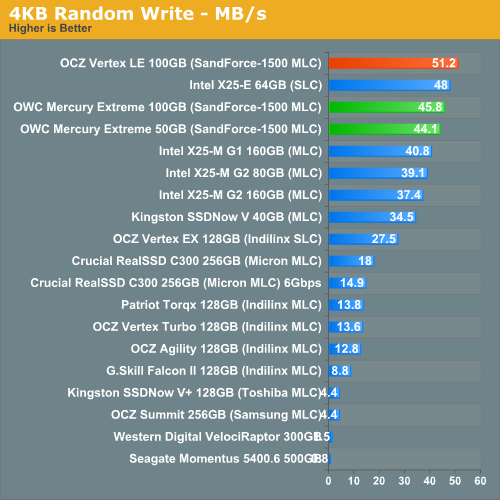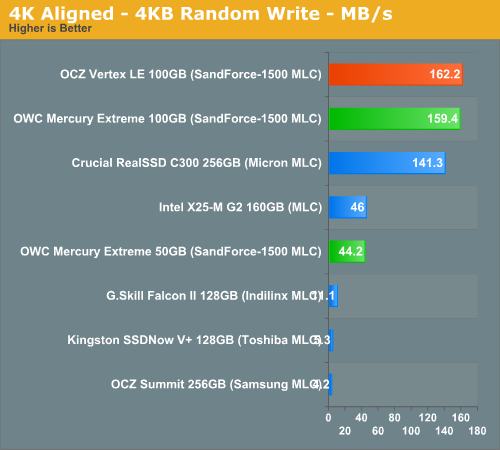OWC Mercury Extreme SSD - First Look at a 50GB SandForce Drive
by Anand Lal Shimpi on February 26, 2010 12:00 AM EST- Posted in
- Storage
Random Read/Write Speed
This test writes 4KB in a completely random pattern over an 8GB space of the drive to simulate the sort of random writes that you'd see on an OS drive (even this is more stressful than a normal desktop user would see). I perform three concurrent IOs and run the test for 3 minutes. The results reported are in average MB/s over the entire time.
I've had to run this test two different ways thanks to the way the newer controllers handle write alignment. Without a manually aligned partition, Windows XP executes writes on sector aligned boundaries while most modern OSes write with 4K alignment. Some controllers take this into account when mapping LBAs to page addresses, which generates additional overhead but makes for relatively similar performance regardless of OS/partition alignment. Other controllers skip the management overhead and just perform worse under Windows XP without partition alignment as file system writes are not automatically aligned with the SSD's internal pages.
First up is my traditional 4KB random write test, each write here is aligned to 512-byte sectors, similar to how Windows XP might write data to a drive:

Unaligned 4KB random writes are a bit lower, but nothing tremendous. For some reason both of the OWC Mercury drives actually performed lower than our Vertex LE sample in this test. These should all be the same drive. As we saw in the last review however, in order to better represent performance under modern OSes we need to look at 4K aligned writes since that's what ends up happening most of the time.

Peak random write performance isn't nearly as good on the 50GB drive. While the 100GB SF-1500 based drives can muster around 160MB/s, the 50GB drive can only manage 44.2MB/s. It's not a deal breaker by any means, and shouldn't really be noticeable in real world usage - but this is the downside to the 50GB drive. Note that at 44.2MB/s, it's still roughly the same speed as Intel's X25-M G2.











74 Comments
View All Comments
SeanFowler - Friday, February 26, 2010 - link
You mention the performance that's lost on the 50GB platform, which is interesting.As an SSD noob I wasn't aware that performance on smaller drives could be significantly slower than the performance on larger drives of the same series.
I had the 100GB LE on order, then cancelled it to order the C300 as I have Sata3, then found out that the 128GB C300 drive has mediocre write speeds (up to 140MB/s). Talk about a mess!
I see that you and most other sites tend to focus on the largest drives in a series, typically 256GB. Are these really the drives most of your readers are buying though? Based on your LE review and SSD round-up I went for the C300. I can't help thinking that your recommendations would have been very different had you instead tested the 128GB drives. Btw there's more info about the slow write speeds in my comment on the LE article, left earlier today.
I'm now in a bit of a quandry. Do I try to get an LE after all? Will it also have significantly poorer write performance than the 256GB version that everyone's reviewing? Help me Anand Kenobi; you're my only hope!
greenguy - Saturday, February 27, 2010 - link
I bought 3 of the Intel x25-V 40GB drives recently - two for a workstation (mirrored boot drive), and one for my home system. I think that most people who run operating systems other than MS (e.g. Linux, BSD, OpenSolaris) would only really need around the 40-50GB mark. When I look at my Linux system that has been running over a year, the OS and apps part of the drive (i.e. that which benefits from an SSD), it doesn't come anywhere near the 40GB mark.Everything else is media, and even Samsung's 5200RPM HDD is faster than these really need to be. 80MB/s and Bluray's max speed is 7MB/s. As a media drive, most of these will be used write once, read many, and for a read speed of 7MB/s, that's only 500rpm.
Only gamers are going to benefit from larger SSDs, and that's only if they can't be bothered in copying saved game files and settings to the storage drive after deleting whatever games they have gotten sick of. Or simply moving the directory to the storage drive and moving it back when done.
When prices come down again, you can buy more and raid them. This will give nearly double the speed for equivalent cost of buying say, an 80GB drive.
Really, $/GB is a pretty poor metric when evaluating these drives for use as a boot drive. Random 4k read speed/$ is probably the best, with one eye on the random writes (so long as the drive is bigger than say, $30GB).
Of course, this is not the case for laptop drives unless you can fit both a boot and a storage drive in them.
Anand Lal Shimpi - Friday, February 26, 2010 - link
I usually try to review the sweetspot drive, Micron sent out only 256GB drives for review but normally I focus on the ~120GB drives. The LE I tested was a 100GB drive, so you can see where your performance would have been. I'll request a 128GB drive from Crucial right away :)SeanFowler - Friday, February 26, 2010 - link
Thanks Anand; I was forgetting you'd reviewed the 100GB LE rather than the 200GB version. This is probably the one for me to go for then.Another interesting subject is what impact read and write speeds have on the perceived performance of an OS drive. I would expect the read speed to be more important than the write speed as OS drives do more reads than writes.
This could mean that the extra 70MB/s read speed the C300 gives over the LE compensates for the 110MB/s deficit in write speeds.
I could cancel the C300 order and wait to see what's what in a week or so, but by that time the LE's will probably have sold out. The safest option right now seems to be the LE.
Crypticone - Friday, February 26, 2010 - link
I too am not sure what drive to purchase right now. I would really like to see the performance of the C300 in SATA 6gig mode on the Storage Bench. Any chance of running this test? I am interested to see if the faster interface would improve apps and games loading, etc in the real world.Anand Lal Shimpi - Friday, February 26, 2010 - link
6Gbps SATA will only improve large file read performance off of the drive. Loading apps and games shouldn't be any faster. Nearly all high performance SSDs load a single app/game in about the same time.vol7ron - Saturday, February 27, 2010 - link
That might be true presently, but shouldn't that change as apps/games take advantage of more cores while loading and executing?vol7ron
pesos - Friday, February 26, 2010 - link
Very cool! Any plans to let the IT side guys take a crack at these in RAID configurations and let them lose on some database benchmarks?pesos - Friday, February 26, 2010 - link
I meant let them LOOSE of course - they probably wouldn't loseviewwin - Friday, February 26, 2010 - link
When will we hear more about the consumer level controller, SF-1200?